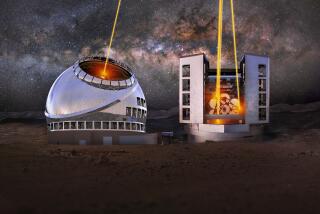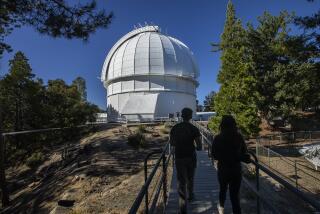South Pole telescope peers heavenward for dark energy
AMUNDSEN-SCOTT STATION, ANTARCTICA — Anywhere on Earth this would be a big telescope, as tall as a seven-story building, with a main mirror measuring 32 1/2 feet across. But here at the South Pole, it seems especially large, looming over a barren plain of ice that gets colder than anywhere else on the planet.
Scientists built the instrument at the end of the world so they can search for clues that might identify the most powerful, plentiful but elusive substance in the universe: dark energy.
First described just nine years ago, dark energy is a mysterious force so powerful that it will decide the fate of the universe. Having already overruled the laws of gravity, it is pushing galaxies away from one another, causing the universe to expand at an ever faster rate.
Though dark energy is believed to account for 70% of the universe’s mass, it is invisible and virtually undetectable. Nobody knows what it is, where it is or how it behaves.
“If you see it in your basement,” jokes University of Chicago cosmologist Rocky Kolb, “you better get back on your medication.” But he knows better than most the high priority the world’s governments and scientists have placed on gaining a fuller understanding of the invisible force.
“Many think dark energy is the most important problem in physics today,” said Kolb, who recently served as chairman of the Dark Energy Task Force, convened in 2005 by the U.S. Department of Energy, NASA and the National Science Foundation.
Figuring out what dark energy is would explain the history and future of the universe and generate new understanding of physical laws that, applied to human invention, almost certainly would change the way we live -- just as breakthroughs in quantum mechanics brought the computer chip.
Swinging its massive mirror skyward, the South Pole Telescope has begun to search the southern polar heavens for shreds of evidence of the elusive stuff. Controlled remotely from the University of Chicago, the $19.2-million telescope has quickly succeeded in its first mission: finding unknown galaxy clusters, clues to the emergence of dark energy.
Ambitious project
The Chicago university has a stronger astronomy presence at the pole than perhaps any other institution, having built several smaller experimental telescopes there over the last 20 years. This scope, however, was the most ambitious project by far.
Its components had to be custom-built by scientists and craftsmen in several different parts of the world, then shipped to Antarctica in pieces for final assembly. The largest sections of the telescope were carefully designed so each could fit into ski-equipped military transport planes. It took 25 flights in all to ferry 260 tons of telescope components.
Late last year, a crew mostly made up of graduate students spent eight hours a day outdoors to help put them all together.
“It gets really, really cold, because you aren’t moving much,” said Joachin Vieira, 28, a graduate student in physics. “There’s steel behind you, steel in front of you, and you’re holding steel tools.” His crew was assembling a 10-meter aluminum mirror and attaching it to a carbon-fiber backing designed to keep the mirror rigid in the powerful South Pole winds.
Earlier they had spent three months doing a dry run on the mirror assembly in the blazing summer heat of Kilgore, Texas. At the pole, temperatures never exceeded 20 degrees below zero Fahrenheit. Crew members said it took hours indoors before their fingers limbered up enough to type on their computers.
“We have to get these pieces into place to within 1/2,000th of an inch of accuracy,” said Jeff McMahon, 29, a postdoctoral physics student. “If you move, you risk screwing it up, so you stand motionless at 20 degrees below zero.”
Also out there, slinging two-by-fours alongside ironworkers putting together the telescope’s main structure, was John E. Carlstrom, a veteran South Pole astronomer and University of Chicago astrophysicist who is heading up the international team that designed and constructed the telescope.
Senior scientists at six other institutions are collaborating with Carlstrom’s Chicago team, including the University of Illinois at Urbana-Champaign, UC Berkeley, NASA’s Jet Propulsion Laboratory, and Harvard, Case Western Reserve and McGill universities. The project is funded mainly by the National Science Foundation with additional money coming from two California donors, the Kavli Foundation and the Gordon and Betty Moore Foundation.
A thoughtful, soft-spoken man, Carlstrom honed his skills at physical labor by working in construction during his college-student days. He seems genuinely excited to be in the middle of the hunt for an elusive quarry, but still flummoxed by the astonishing new realities that dark energy represents.
“It’s odd that we find ourselves missing the density of 70% of the universe,” he said. “It’s a hard pill to swallow, that this thing dominates the universe, but there is a lot of evidence to say that it is there.”
Old-time methods
The problems Carlstrom and his team are trying to solve are 21st century, and so is much of the technology they are using, but their methodology is old school.
For thousands of years, astronomers have been puzzling out the size, shape and chemistry of the universe, first by naked eye and then with increasingly powerful and sophisticated telescopes. Mostly they study the motion of very large objects and apply the known laws of physics to analyze what they see.
The telescope can’t go looking for dark energy directly. Instead, it is gathering information that researchers hope will lead to a better understanding of the mysterious force, by tracing for the first time how dark energy emerged and changed over billions of years.
To do that, scientists will use the South Pole Telescope to search for enormous clusters of galaxies -- the last structures in the universe to be forged by the force of gravity after the Big Bang. First, gravity formed the stars, then the galaxies, and finally vast clusters containing 50 to 1,000 galaxies.
But at some point dark energy got the upper hand over gravity, slowing down and stopping gravitational formations and instead beginning to push galaxies away from one another.
“It’s not incorrect to think of dark energy as acting like negative gravity,” Carlstrom said. In other words, it is a force that causes all physical matter to push away rather than collapse together.
The idea behind the South Pole Telescope is to try to trace how many galaxy clusters have formed at different periods in the history of the universe, how they formed, and when dark energy slowed or stopped their formation.
“We’re looking at a tug-of-war with dark energy and gravity trying to expand or collapse the universe,” said Carlstrom, 50.
Galaxy clusters are rare, holding perhaps just 1% of all the stars in the universe, and most are so far away and faint that most optical and radio telescopes cannot detect them.
Instead, scientists need to find tiny variations in temperature of the cosmic microwave background, which are remnants of the first light in the universe, emerging 400,000 years after the Big Bang. Slightly warmer spots in the background indicate the presence of the dim, distant, hard-to-locate galaxy clusters.
And the South Pole, inhospitable as it is, is the best place on Earth to do that.
Humidity in the atmosphere would distort signals the telescope receives and, thus, the picture it makes. But there is very little water vapor at the South Pole. Even though the pole sits on a massive, million-year buildup of ice 10,000 feet deep, the area is a natural desert -- the air is dry and it almost never snows.
In addition, because of the tilt of the Earth’s axis, the pole for nearly half the year is bathed in 24-hour-a-day darkness. That allows researchers to focus the telescope continuously on one part of the sky for long periods.
Light recorded
To do its work, the telescope takes advantage of the Sunyaev-Zel’dovich effect, a phenomenon named for two Russians who discovered it in the 1960s.
As the particles of light that make up the microwave background travel through space, some encounter the hot gas cores of distant galaxy clusters. The Russians predicted that about 1% of photons passing through the gas cores would interact with electrons there, slightly kicking up their energy.
The telescope’s main mirror collects photons as they arrive at our planet and sends them to an array of bolometers that record their intensity. The bolometers, the most crucial elements in the scope, contain sensors that can measure temperature differences up to 10-millionths of a degree.
Ironically, the weather at the South Pole is much too warm for the bolometers to work. The cosmic microwave background has cooled to a nearly uniform 454.765 below zero Fahrenheit, or 2.725 degrees on the Kelvin scale.
To detect the photons’ slight variations in temperature, scientists had to plan for cryogenic freezers that would keep the bolometers just a quarter-degree Kelvin above absolute zero, or 459.22 degrees below zero Fahrenheit.
Ultimately the telescope produces a picture revealing slightly more intense patches in the cosmic microwave background -- in effect, a map pinpointing the location and mass of the galaxy clusters that heated up passing photons.
Back in Illinois, the University of Chicago receives and stores all data from the telescope.
When the sun went down at the pole last March, the telescope passed all its preliminary tests and began successfully searching out unknown galaxy clusters in small patches of the sky, babied by two scientists who stayed through the long polar night.
“It’s unusual for an instrument of this complexity to make good observations so soon after deployment,” said product manager Stephen Padin, 47, a senior University of Chicago scientist who recently left the pole after more than a year helping work out technical issues.
One surprisingly low-tech hitch, however, will keep the telescope from operating at 100% until early 2009.
The telescope is designed to nest inside a huge metal shield -- a 75-foot-high, 155-foot-wide bowl-shaped structure that will block ambient light traveling from South Pole buildings two-thirds of a mile away. Even those minute sprinkles of light can be enough to skew the telescope’s super-sensitive sensors in certain sectors of the sky.
Once the shield is in place, the telescope should complete its exhaustive survey in two or three years.
Designed for a 20-year life, the telescope will be assigned to other tasks when the cluster survey is done.
Carlstrom and his colleagues think the survey will provide breakthrough information on dark energy by documenting its first interactions with ordinary matter. Just as important, the telescope’s cluster inventory will serve as a guide for other telescopes to glean far more information on dark energy’s attributes by zeroing in with specialized detectors that the South Pole scope lacks.
Eventually, when astronomers know more about how to look at dark energy itself, the quest may require powerful space-based telescopes, said Kolb of the Dark Energy Task Force.
“We in astronomy think dark energy is a billion-dollar question,” Kolb said. “We feel it is that fundamental. It is a big question that will require a big effort to answer it.”






